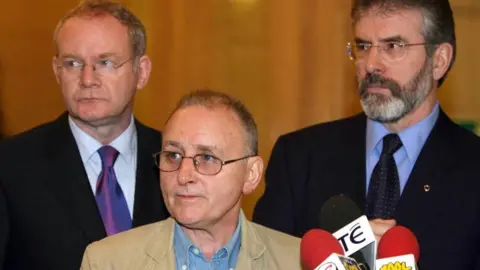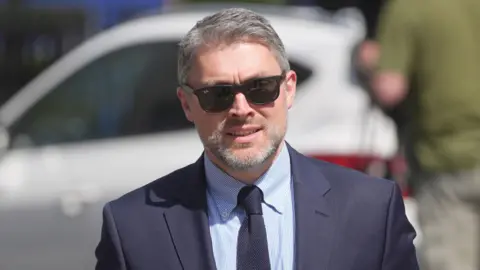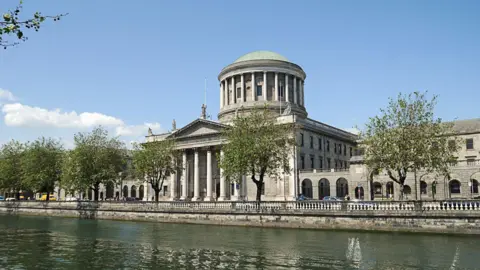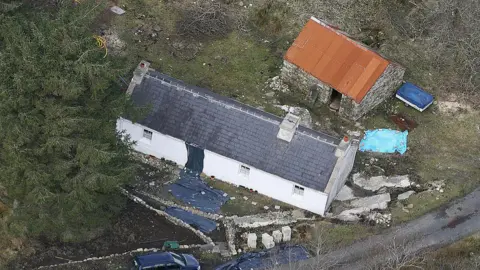Murdered agent viewed as 'expendable', Adams tells court
 PA Media
PA MediaFormer Sinn Féin president Gerry Adams has said informer Denis Donaldson was "a victim of the conflict", whom his state handlers viewed as being "expendable".
Mr Donaldson, who had worked for Sinn Féin, was shot dead in Donegal in 2006, months after admitting his role as a police and MI5 agent for 20 years.
The comments came as Mr Adams, 76, gave evidence in his libel case against the BBC at Dublin's High Court.
Mr Adams believes he was he was defamed in a 2016 programme which, he claims, was wrong to allege he sanctioned the murder of Mr Donaldson.
Mr Adams denies any involvement.
In 2009, the Real IRA admitted killing Mr Donaldson.
The case is being heard by a jury at the High Court in Dublin and could last four weeks.
 PA Media
PA MediaMr Adams also alleges he was defamed in a BBC online article based on the broadcast - a BBC NI Spotlight TV documentary - which contained claims made by an anonymous source.
During pre-trial hearings, the BBC argued the broadcast and publication were put out in good faith and concerned a matter of public interest.
It stated the reports constituted responsible journalism as a result of careful investigation.
 PA Media
PA MediaGiving evidence on Wednesday, Mr Adams told the libel jury he was "shocked" when told that Mr Donaldson had been shot dead at a remote cottage in Donegal.
He said he learned of the killing in a phone call from the then Northern Ireland Secretary, Peter Hain.
Asked his reaction, Mr Adams replied: "I was shocked."
He said: "The Sunday World carried the story a few weeks before and there was a photograph outside cottage.
"I presumed he had moved and hadn't left himself vulnerable, but unfortunately he didn't."
He continued: "I think Denis Donaldson was victim of the conflict.
"The fact his family is still struggling to get the truth, even an inquest, is deeply troubling."
'Alternative' to IRA needed
Earlier on Wednesday, Mr Adams, under questioning from his own legal team, spoke about the outset of the Northern Ireland Troubles, when "the entire situation moved from a civil rights struggle to a conflict situation".
He dealt with his internment without trial in the 1970s and the 1981 Republican hunger strikes, by which time he was Sinn Féin vice president.
One of those who died on hunger strike was Bobby Sands, who was elected an MP months earlier.
"A number of us were trying to revamp Sinn Féin," Mr Adams said.
"What Bobby's [Sands] election did was accelerated that process.
"That was the commencement of the Sinn Féin electoral strategy, but also the notion you could go forward peacefully."
 Getty Images
Getty ImagesMr Adams then talked about the development of the peace process.
"The IRA was legitimate response to [British] occupation. That's not to say everything they did was legitimate, it wasn't."
He said he told a priest, Fr Alec Reid: "If we want the IRA to stop, we have to produce an alternative.
"That became my mantra."
Mr Adams said he was "shocked" at how long things took.
"It was too long and all the time there were people being killed - there were atrocities, including on the republican side."
The case continues.
Who is Gerry Adams?
Mr Adams was the former president of republican party Sinn Féin from 1983 until 2018.
He served as MP in his native west Belfast from 1997 until 2011 before sitting as a TD (Teachta Dála) in the Dáil (Irish parliament) between 2011 and 2020.
Mr Adams led the Sinn Féin delegation during peace talks that eventually brought an end to the Troubles after the signing of the Good Friday Agreement in 1998.
He was detained in the early 1970s when the government in Northern Ireland introduced internment without trial for those suspected of paramilitary involvement.
Mr Adams has consistently denied being a member of the IRA.
Who was Denis Donaldson?
 Getty Images
Getty ImagesMr Donaldson was once a key figure in Sinn Féin's rise as a political force in Northern Ireland but he was found brutally murdered in 2006 after it emerged he had been an informer.
He was interned without trial for periods in the 1970s.
After the signing of the Good Friday Agreement, Sinn Féin appointed Mr Donaldson as their key administrator in the party's Stormont offices.
In 2005, Mr Donaldson confessed that he was a spy for British intelligence for two decades, before disappearing from Belfast.
He was found dead in a small, run down cottage in Glenties, County Donegal.
